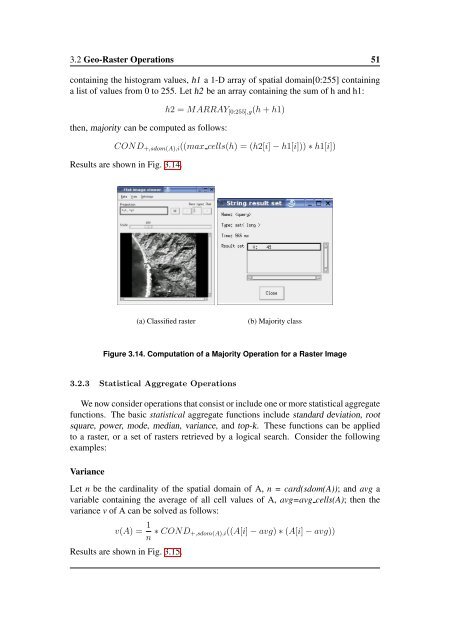Applying OLAP Pre-Aggregation Techniques to ... - Jacobs University
Applying OLAP Pre-Aggregation Techniques to ... - Jacobs University
Applying OLAP Pre-Aggregation Techniques to ... - Jacobs University
You also want an ePaper? Increase the reach of your titles
YUMPU automatically turns print PDFs into web optimized ePapers that Google loves.
3.2 Geo-Raster Operations 51<br />
containing the his<strong>to</strong>gram values, h1 a 1-D array of spatial domain[0:255] containing<br />
a list of values from 0 <strong>to</strong> 255. Let h2 be an array containing the sum of h and h1:<br />
h2 = MARRAY [0:255],g (h + h1)<br />
then, majority can be computed as follows:<br />
COND +,sdom(A),i ((max cells(h) = (h2[i] − h1[i])) ∗ h1[i])<br />
Results are shown in Fig. 3.14.<br />
(a) Classified raster<br />
(b) Majority class<br />
Figure 3.14. Computation of a Majority Operation for a Raster Image<br />
3.2.3 Statistical Aggregate Operations<br />
We now consider operations that consist or include one or more statistical aggregate<br />
functions. The basic statistical aggregate functions include standard deviation, root<br />
square, power, mode, median, variance, and <strong>to</strong>p-k. These functions can be applied<br />
<strong>to</strong> a raster, or a set of rasters retrieved by a logical search. Consider the following<br />
examples:<br />
Variance<br />
Let n be the cardinality of the spatial domain of A, n = card(sdom(A)); and avg a<br />
variable containing the average of all cell values of A, avg=avg cells(A); then the<br />
variance v of A can be solved as follows:<br />
v(A) = 1 n ∗ COND +,sdom(A),i((A[i] − avg) ∗ (A[i] − avg))<br />
Results are shown in Fig. 3.15.
















